
The Umtamvuna Nature Reserve is situated in South Africa on the KwaZulu-Natal side of the Mtamvuna River, and is managed by Ezemvelo KZN Wildlife. The reserve is 3,257 hectares in extent and was established on 25 July 1971.

Barringtonia racemosa is a tree in the family Lecythidaceae. It is found in coastal swamp forests and on the edges of estuaries in the Indian Ocean, starting at the east coast of Mozambique and KwaZulu-Natal to Madagascar, India, Sri Lanka, Malaysia, Maldives, Thailand, Laos, southern China, northern Australia, coastal Taiwan, the Ryukyu Islands and many Polynesian islands.
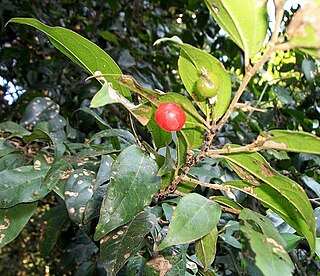
Celtis mildbraedii is a species of forest tree in the family Cannabaceae. It was previously assigned to the family Ulmaceae. These trees grow in limited areas of South Africa, Mozambique and Zimbabwe. They are also found in forested areas from West Africa to Sudan, DRC, Angola and Tanzania. Common names include natal white stinkwood, red-fruited white-stinkwood and natal elm. This species is more common in Tropical Africa than in Southern Africa.
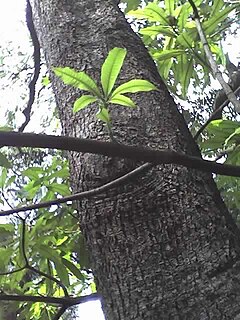
Rauvolfia caffra is a tree in the family Apocynaceae. It is commonly known as the quinine tree. These trees are distributed from the Eastern Cape of South Africa to tropical Africa and are found in low-lying forests near rivers and streams, or on floodplains.

Millettia grandis is a species of legume in the family Fabaceae from South Africa. It is commonly called Umzimbeet which is a name derived from the isiZulu name umSimbithwa.
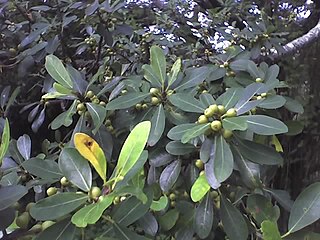
Ficus natalensis is a tree in the family Moraceae. It is commonly known as the Natal fig, or "Mutuba" to locals. These trees are distributed from north-eastern South Africa to Uganda and Kenya.

Ficus lutea is a tree in the family Moraceae. It is commonly known as the giant-leaved fig or Lagos rubbertree. These trees occur from the Eastern Cape of South Africa to Tropical Africa.

Ficus stuhlmannii is a tree in the family Moraceae. It is commonly known as the lowveld fig. These trees are distributed from KwaZulu-Natal in South Africa to east Africa.

Aloe thraskii, the dune aloe, is a South African plant in the genus Aloe.

Croton sylvaticus is a tree in the family Euphorbiaceae. It is commonly known as the forest fever-berry. These trees are distributed in forests from the east coast of South Africa to Tropical Africa. It grows 7–13 m in height, occasionally up to 30 m, in moist forests, thickets and forest edges at altitudes of 350–1800 m.

KwaZulu-Natal coastal lowland forest is a subtropical forest type that was once found almost continuously along the low-lying coastal areas of KwaZulu-Natal, South Africa. It still exists in protected areas, but much has been cleared for sugar-cane plantations and housing developments.
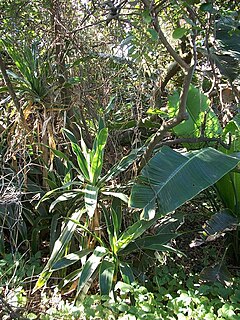
KwaZulu-Natal Dune Forest is a subtropical forest type that was once found almost continuously along the coastal dunes of KwaZulu-Natal, South Africa. This vegetation type develops in sheltered areas behind the littoral zone, where with some protection from the salt wind it may develop with canopies as tall as 30 m. It still exists in protected areas, but much has been degraded by human activity. Coastal dune forest covers approximately 1% of the land area of KwaZulu-Natal, and is a habitat type seriously threatened from human population pressure and development.

Dracaena aletriformis is commonly known as the large-leaved dragon tree. These plants are found in forest in the eastern areas of South Africa from Port Elizabeth to northern and eastern Limpopo. They are also found in Eswatini, but are most common in the coastal and dune forests of KwaZulu-Natal.

Deinbollia oblongifolia is a shrub or small tree in the family Sapindaceae. It is commonly known as the dune soap-berry and is found in coastal vegetation from the Eastern Cape of South Africa, through KwaZulu-Natal to southern Mozambique and Swaziland. It is named after Peter Vogelius Deinboll (1783-1876), a Danish botanist and plant collector.

Southern African Sand Forest is a sand forest, or a subtropical forest plant community of the tropical and subtropical dry broadleaf forests biome. It grows on ancient sand dunes in northern KwaZulu-Natal and southern Mozambique. In South Africa these forests are known simply as Sand Forest, while in Mozambique they are known as Licuati Forest. The Southern African sand forest is part of the Maputaland coastal forest mosaic ecoregion.

Bridelia micrantha, the mitzeeri or the coastal golden-leaf, is a tree in the family Phyllanthaceae and is native to tropical and southern Africa as well as to the island of Réunion in the Indian Ocean.
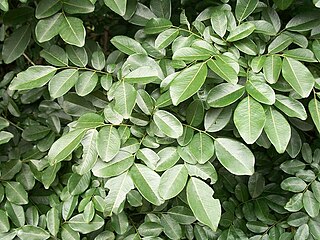
Dalbergia obovata is a robust shrub or climber in the family Fabaceae, and is native to Southern Africa.

Combretum kraussii, the forest bushwillow, is a medium-sized to large tree of eastern South Africa, Swaziland and southern Mozambique, which is found within, or in the vicinity of forests. The specific name commemorates Dr. F. Krauss who undertook a collecting trip to South Africa from 1838 to 1840.

Dalbergia armata is a scrambling, deciduous species of legume that is native to subtropical to temperate regions of southeastern Africa. The robust, woody liana or small tree is armed with strong spines on the main stem and branches. It occurs sparsely or commonly in forest, bush, riparian fringes and in wooded ravines. It is sometimes employed as a bonsai subject, and it can be propagated from either seed or cuttings.
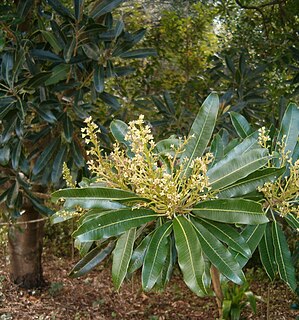
Protorhus longifolia, the red beech, is a medium to large, mostly dioecious species of tree in the family Anacardiaceae. It is native to South Africa and Eswatini, where it occurs in well-watered situations from coastal elevations to 1,250 m. The leafy, evergreen trees have rounded crowns and usually grow between 6 and 10 m tall, but regularly taller in forest.


























